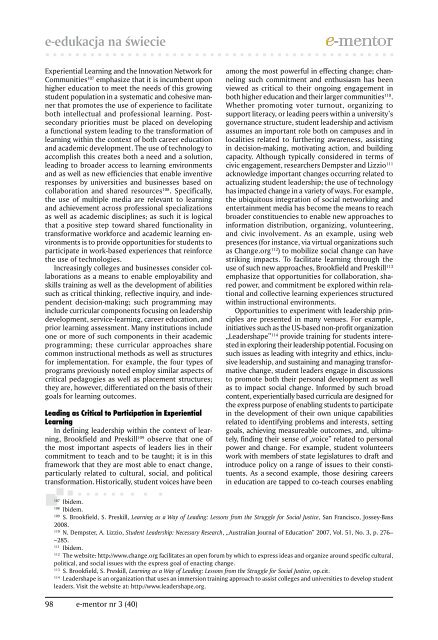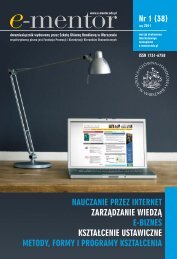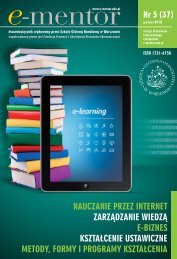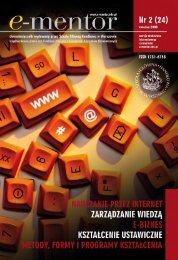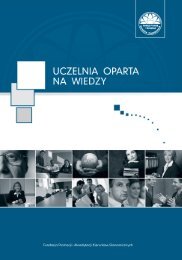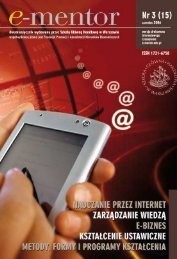metody, formy i programy ksztaÅcenia - E-mentor
metody, formy i programy ksztaÅcenia - E-mentor
metody, formy i programy ksztaÅcenia - E-mentor
Create successful ePaper yourself
Turn your PDF publications into a flip-book with our unique Google optimized e-Paper software.
e-edukacja na świecieExperiential Learning and the Innovation Network forCommunities 107 emphasize that it is incumbent uponhigher education to meet the needs of this growingstudent population in a systematic and cohesive mannerthat promotes the use of experience to facilitateboth intellectual and professional learning. Postsecondarypriorities must be placed on developinga functional system leading to the transformation oflearning within the context of both career educationand academic development. The use of technology toaccomplish this creates both a need and a solution,leading to broader access to learning environmentsand as well as new efficiencies that enable inventiveresponses by universities and businesses based oncollaboration and shared resources 108 . Specifically,the use of multiple media are relevant to learningand achievement across professional specializationsas well as academic disciplines; as such it is logicalthat a positive step toward shared functionality intransformative workforce and academic learning environmentsis to provide opportunities for students toparticipate in work-based experiences that reinforcethe use of technologies.Increasingly colleges and businesses consider collaborationsas a means to enable employability andskills training as well as the development of abilitiessuch as critical thinking, reflective inquiry, and independentdecision-making; such programming mayinclude curricular components focusing on leadershipdevelopment, service-learning, career education, andprior learning assessment. Many institutions includeone or more of such components in their academicprogramming; these curricular approaches sharecommon instructional methods as well as structuresfor implementation. For example, the four types ofprograms previously noted employ similar aspects ofcritical pedagogies as well as placement structures;they are, however, differentiated on the basis of theirgoals for learning outcomes.Leading as Critical to Participation in ExperientialLearningIn defining leadership within the context of learning,Brookfield and Preskill 109 observe that one ofthe most important aspects of leaders lies in theircommitment to teach and to be taught; it is in thisframework that they are most able to enact change,particularly related to cultural, social, and politicaltransformation. Historically, student voices have beenamong the most powerful in effecting change; channelingsuch commitment and enthusiasm has beenviewed as critical to their ongoing engagement inboth higher education and their larger communities 110 .Whether promoting voter turnout, organizing tosupport literacy, or leading peers within a university’sgovernance structure, student leadership and activismassumes an important role both on campuses and inlocalities related to furthering awareness, assistingin decision-making, motivating action, and buildingcapacity. Although typically considered in terms ofcivic engagement, researchers Dempster and Lizzio 111acknowledge important changes occurring related toactualizing student leadership; the use of technologyhas impacted change in a variety of ways. For example,the ubiquitous integration of social networking andentertainment media has become the means to reachbroader constituencies to enable new approaches toinformation distribution, organizing, volunteering,and civic involvement. As an example, using webpresences (for instance, via virtual organizations suchas Change.org 112 ) to mobilize social change can havestriking impacts. To facilitate learning through theuse of such new approaches, Brookfield and Preskill 113emphasize that opportunities for collaboration, sharedpower, and commitment be explored within relationaland collective learning experiences structuredwithin instructional environments.Opportunities to experiment with leadership principlesare presented in many venues. For example,initiatives such as the US-based non-profit organization„Leadershape” 114 provide training for students interestedin exploring their leadership potential. Focusing onsuch issues as leading with integrity and ethics, inclusiveleadership, and sustaining and managing transformativechange, student leaders engage in discussionsto promote both their personal development as wellas to impact social change. Informed by such broadcontent, experientially based curricula are designed forthe express purpose of enabling students to participatein the development of their own unique capabilitiesrelated to identifying problems and interests, settinggoals, achieving measureable outcomes, and, ultimately,finding their sense of „voice” related to personalpower and change. For example, student volunteerswork with members of state legislatures to draft andintroduce policy on a range of issues to their constituents.As a second example, those desiring careersin education are tapped to co-teach courses enabling107Ibidem.108Ibidem.109S. Brookfield, S. Preskill, Learning as a Way of Leading: Lessons from the Struggle for Social Justice, San Francisco, Jossey-Bass2008.110N. Dempster, A. Lizzio, Student Leadership: Necessary Research, „Australian Journal of Education” 2007, Vol. 51, No. 3, p. 276––285.111Ibidem.112The website: http://www.change.org facilitates an open forum by which to express ideas and organize around specific cultural,political, and social issues with the express goal of enacting change.113S. Brookfield, S. Preskill, Learning as a Way of Leading: Lessons from the Struggle for Social Justice, op.cit.114Leadershape is an organization that uses an immersion training approach to assist colleges and universities to develop studentleaders. Visit the website at: http://www.leadershape.org.98 e-<strong>mentor</strong> nr 3 (40)


